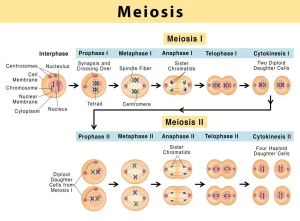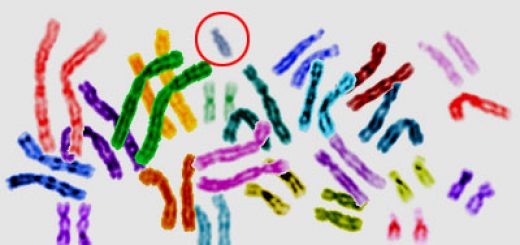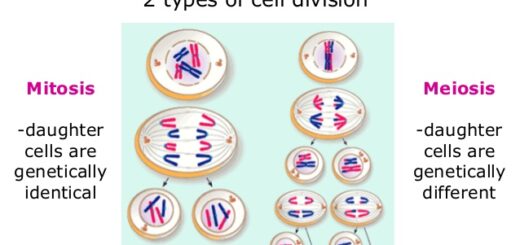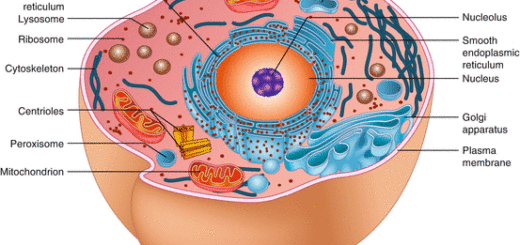Phases of Meiotic cell division (Meiosis), Nanotechnology and cancer treatment
The mitotic division is more important for children than meiosis because mitosis division plays an important role in growth which the body of a child needs, while meiosis division aims to the production of gametes in adults only. The gametes are often (N), while somatic cells are often (2N) because gametes are produced by meiosis division, while somatic cells are produced by mitosis division.
Meiotic cell division (Meiosis)
Meiotic cell division (Meiosis): It is a type of cell division at which a reproductive cell divides into four new cells (gametes), each of them contains half the number of chromosomes (haploid number) of the parent reproductive cells.
Site of occurrence: It occurs only in the reproductive cells:
- In humans and animals: It occurs in the testes (to produce male gametes (sperms)] and in the ovaries [to produce female gamete (ovum)]. (pl. ova).
- In flowering plants: It occurs in the anther [to produce male gametes (pollen grains)] and in the ovary [to produce female gametes (eggs or ova)].
Importance of meiosis
Production of male gametes and female gametes to complete sexual reproduction.
Phases of meiosis
Before starting meiosis, the cell passes through the interphase. The meiotic division takes place in two stages:
- First meiotic division.
- Second meiotic division.
First meiotic division
It produces two cells, each of them contains half the number of chromosomes.
Phases of the first meiotic division are: Prophase I ⇒ Metaphase I ⇒ Anaphase I ⇒ Telophase I
Phases of first meiotic division
Prophase I
In this phase: the Chromatin reticulum condenses (intensifies). then appears in the form of long, thin, and double-strings chromosomes. Chromosomes are arranged in homologous pairs, each pair consists of 4 chromatids which are called a tetrad. Tetrad is the arrangement of homologous pairs of chromosomes, where each pair consists of 4 chromatids.
At the end of this phase: Crossing over phenomenon occurs. Nucleolus and nuclear membrane disappear. The spindle fibers are formed and connected to the chromosomes at the centromere. Every two homologous chromosomes (in the tetrad) start to move away from each other.
Metaphase I
In this phase: The chromosomes pairs which are connected with the spindle fibers are arranged at the cell equator.
Anaphase 1
In this phase: The spindle fibers begin to shrink, so every two homologous chromosomes move away from each other. Each one of the two homologous chromosomes migrates towards the cell pole, and the other one migrates towards the other cell pole. Therefore, each cell pole contains half the number of chromosomes of the parent cell.
Telophase I
In this phase: The spindle fibers disappear, and A nuclear membrane is formed around the chromosomes at each of the cell’s poles leading to the formation of two new nuclei, A nucleolus is formed at each pole of the cell.
At the end of this phase: The cell divides into two new cells, the nucleus of each of them contains half number of chromosomes (N) of the parent cell.
The crossing-over phenomenon
The traits are different between members of the same species, this is due to the crossing-over phenomenon. Crossing over phenomenon is a phenomenon that takes place at the end of prophase I in which some parts of the two inner chromatids of each tetrad are exchanged to produce new genetic arrangements.
Meiosis is considered the source of genetic variation on which the variation of organisms depends on due to the occurrence of the crossing-over phenomenon during it. Crossing over phenomenon plays an important role in meiosis because it contributes to genes exchanging between the two homologous chromosome’s chromatids and distributing them randomly in the gametes.
Importance of the crossing-over phenomenon
It works on the variation of genetic traits among the members of the same species. where it contributes to the exchange of genes (that carry genetic traits) between the two homologous chromosome’s chromatids, and distributing them randomly in the gametes.
Second meiotic division
The second meiotic division aims to increase the number of the produced cells from the first meiotic division, where each cell of the two new cells resulted from the first meiotic cell division is divided again in a way similar to mitotic cell division.
In the final phase (telophase II) of this division, four cells (four gametes) are produced and each of them contains half the number (haploid number) of chromosomes of the parent reproductive cell.
Meiotic cell division is called reduction division because the produced cells contain half the number (haploid number) of chromosomes of the parent reproductive cell.
Phases of second meiotic division are Prophase II ⇒ Metaphase II ⇒ Anaphase II ⇒ Telophase II.
In the first meiotic division
- Before starting prophase I, the parent reproductive cell passes through interphase, where genetic material is duplicating.
- Through anaphase I, the centromeres don’t split.
- The resulted cells contain a haploid number of chromosomes (N).
In the second meiotic division
- Before starting prophase II, the resulting cell from the first meiosis doesn’t pass through interphase, so the genetic material is not duplicating.
- Through anaphase II, the centromeres split lengthwise.
- The resulting cells (gametes) contain a haploid number of chromosomes (N).
When the male gamete (N) combines with the female gamete (N) during the fertilization process, the zygote is formed which contains the full number of chromosomes (2N), and so the number of chromosomes is fixed among the members of the same species.
Nano-technology and cancer treatment
Cancer occurs when some of the body cells are divided continuously in an abnormal way without controlling leading to form a mass of cells which is called the tumor.
Tumor: The mass of cells produced due to the abnormal continuous division of cells.
The Egyptian scientist Dr. Mustafa El-Said discovered a way to detect cancer cells and kill them by using very small molecules of gold measured by nanometer unit, so they called Nano-molecules and this technic is called Nano-technology that we can benefit from it in
Discovering cancer disease
Discovering the cells infected with cancer by using Nano-technical as follows: This technique starts by loading proteins (that can attach to the cancerous cell secretions) with Nano-molecules of gold and then injecting them into the patient. The loaded proteins with Nano-molecules of gold pass from the patient’s blood, then attach to the cancerous cell surface to monitor it through a microscope, each cell separately.
Treatment of cancer
- By using loaded protein with Nano-molecules of gold as follows: Focusing laser to a certain degree on the Nano-molecules of gold (present on the cancer cells), then the Nano-molecules of gold absorb the light energy and convert it into heat energy which burns and kills the infected cancer cells, where the healthy cells not affected.
- By using smart microscopic bombs: Using Nanotechnology, scientists have developed smart microscopic bombs that penetrate cancer cells and explode them from inside. They were used to kill the cancer cells in experimental mice. Mice suffering from cancer were able to live 300 days after this treatment. As for mice that did not receive treatment. they did not live more than 43 days.
Nanotechnology is called by this name because in which very small molecules are used and their lengths are measured in nanometer units. Laser is used for the treatment of cancer by nanotechnology because the nano-molecules of gold which are stuck to the surface of cancerous cells absorb the light of the laser and convert it into heat which leads to burns and kills the infected cell.
You can subscribe to science online on YouTube from this link: Science Online
You can download Science Online application on Google Play from this link: Science Online Apps on Google Play
Cells types, Chromosomes, Cell division, Phases of mitosis division & Liver Transplantation
Cell division types, Mitosis, Meiosis, Reductional division & Equatorial division
Cell Structure, the function of Golgi apparatus, Endosomes & Lysosomes
Mitotic cell division (Mitosis) or indirect cell division stages & features
Meiotic cell division (Meiosis) or reduction division stages & features




